If you crave solitude and want to spend time in Washington State’s most beautiful destinations, plan a fall or winter camping trip. “Sometimes you can show up [in the winter] and have a whole park almost completely to yourself,” says Meryl Lipman, communication specialist for Washington State Parks. “It’s like a backcountry experience in the frontcountry.”
Of course, if you plan to camp in the winter or fall in Washington State, you’ll want to pack right. Despite its longitude, Washington has relatively mild fall and winter temperatures that can range from high 50s to low 20s at night, depending on your location, which makes for a fairly comfortable off-season camping experience. However, many parts of Washington get approximately 38.15 inches of rain annually, so proper rain gear is a must. (See our guide to camping in the rain for more details about what to pack for soggy camping trips.) If you plan to camp from December to March in Washington, you may also encounter snow. (See our guide to camping in the snow for more details about what to pack and how to set up camp in icy, snowy climates.)
In this guide, we’ll share our best recommendations for fall and winter camping in Washington State. We’ve included options for dry camping, wet camping, snow camping and even backcountry camping—so whether you’re looking to get off the beaten track or want to sleep in a heated cabin during the offseason, we’ve got you covered.
Here are our top picks for fall and winter camping options in Washington State:
Bridgeport State Park
Best for (Mostly) Dry Fall & Winter Camping
Location: On the Columbia River, 212 miles from Seattle
Fall/Winter Season: October through March
Dogs: Allowed
Access: Drive-up
Accessible Sites Available: Yes; tent sites are accessible to campers with disabilities and there are 2 ADA bathrooms on-site.
Bridgeport State Park offers 622 acres of outdoor recreation along Rufus Woods Lake, directly behind the Chief Joseph Dam on the Columbia River. Because Bridgeport State Park is located in central Washington along the Columbia River, visitors can typically find dry, desert-like climates year-round.
“One of the nice things about this area is that it’s dry, you won’t have to stake your tent in the snow,” says Lipman.
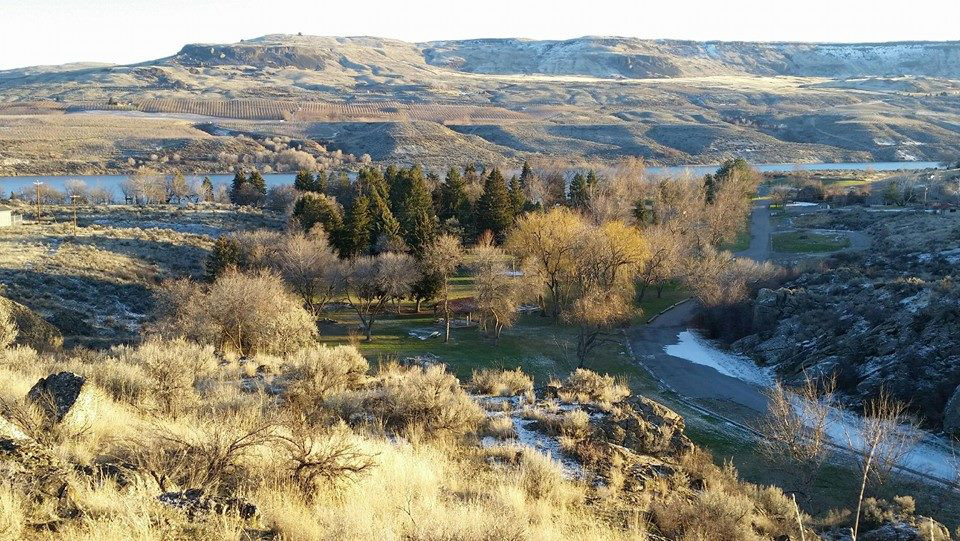
Frost takes hold at Bridgeport State Park. (Photo Credit: Bridgeport State Park/Audra Sims)
At Bridgeport State Park, you’ll find 14 tent camping spaces, 20 water and electric sites, a dump station, two restrooms and even two showers, all of which are available year-round. Almost every site in this park is under the trees, which provides weather protection, rain or shine. Group camping is also available. There are 4 miles of hiking trails within the state park, and there’s very little light pollution, so you’ll be able to stargaze year-round. Plus, the park sits on Rufus Woods Lake, which is known for its quality fishing during the winter months (walleye and rainbow trout are usually in ample supply).
Potlatch State Park
Best for Fall & Winter Camping Near the Beach
Location: Approximately 40 miles north-northwest of Olympia
Fall/Winter Season: October through March
Dogs: Allowed
Access: Drive-up
Accessible Sites Available: Yes; some tent sites are accessible to campers with disabilities but we recommend calling to speak with a ranger about which sites would be best before booking.
If you’re up for a rainy weekend of camping in a beautifully green, crisp location along the ocean, the Puget Sound’s Hood Canal is your best bet. Potlatch State Park’s campgrounds offer 5,700 feet of saltwater shoreline and 84 acres of recreational space. There are 38 standard campsites, 35 partial-hookup sites, two hiker/biker sites, a dump station and three bathrooms, two of which have heated showers.

A camper enjoys the peace of Potlach State Park’s waterside real estate. (Photo Credit: Johan Wieland under CC BY-ND 2.0)
The best thing about this campground is its beach access which, while windy, is still gorgeous beyond compare year-round. In the summer, people come for the shellfish harvesting. In the winter, sea kayakers flock to this area. Don’t forget to bring your kite on windy days!
“If you’re doing an Olympic Peninsula road trip, this is one of the three state parks on the route,” says Lipman. “You can do this as your first or last night, or you can stay here on your way up to Port Angeles or Port Townsend.”
Deception Pass State Park
Best for “Classic PNW” Winter & Fall Camping
Location: Between Whidbey Island and Fidalgo Island, close to Oak Harbor
Fall/Winter Season: October through March
Dogs: Allowed
Access: Drive-up
Accessible Sites Available: Yes; the campsites, some hiking trails, picnic area and several restrooms are accessible for campers with disabilities.
It can be tough to snag a campsite at the well-known Deception Pass State Park during the summer months—and for good reason. Mysterious coves, rugged cliffs, jaw-dropping sunsets and a vertigo-inducing high bridge make visiting this region a quintessential Pacific Northwest experience. You can hike or bike more than 28 miles of trails within the park year-round, but camping at Deception Pass during the fall or winter months is a solid bet, as you’ll get all of the views with none of the crowds. Pro tip: Bring your rain gear, as this area can get quite blustery.
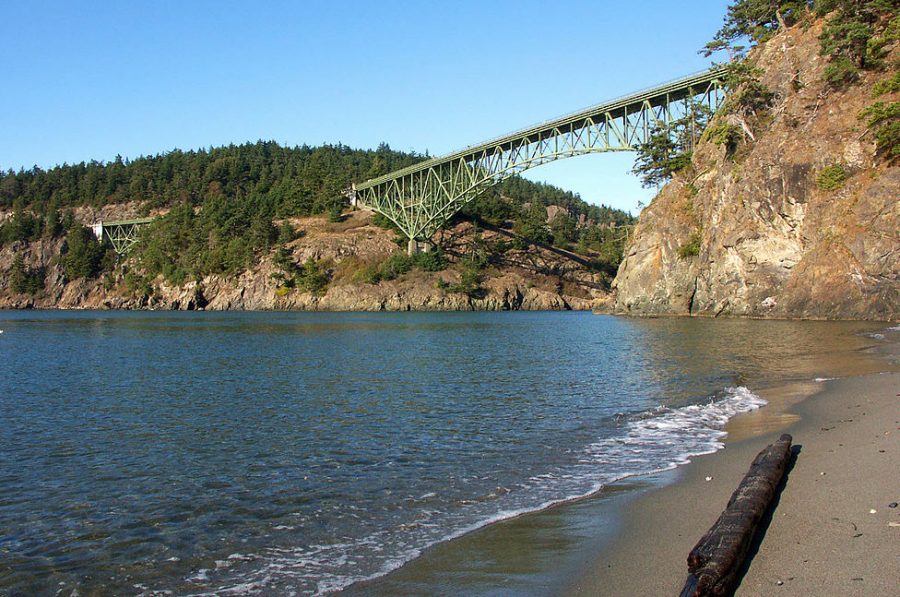
Macs Cove laps in front of the Deception Pass Bridge. (Photo Credit: Tobias Haase under CC BY 2.0)
The campgrounds at Deception Pass have 172 tent sites, 134 partial-hookup sites, five hiker/biker sites, one dump station, one group campsite, 20 restrooms and 10 showers. The campsites are spread out, with some along Bowman Bay, a few on Quarry Pond, fewer still on Hope Island and most at Cranberry Lake. During the winter months (after October 31), camping is limited to Quarry Pond, which has 60 sites. If you’d rather not camp in a tent or RV, there are five cabins available to rent, or you can book the Cornet Bay Retreat Center for large groups.
“You’re close to the gateway to the San Juans here,” says Lipman. “And you can see Fort Casey and Fort Ebey, too.”
Cape Disappointment State Park
Best For Fall & Winter Glamping
Location: At the coastal border of Washington and Oregon, 18 miles from Astoria, Oregon
Fall/Winter Season: October through March
Dogs: Allowed
Access: Drive-up
Accessible Sites Available: Yes; the campsites, hiking trails, interpretive center, restrooms and yurts are all accessible to campers with disabilities.
There’s nothing disappointing about this part of the Pacific Northwest, where lighthouses line the jagged cliffs and the Columbia River meets the Pacific Ocean. Cape Disappointment State Park is a 2,023-acre camping park on Long Beach Peninsula, named for the dangerous currents that occur where the river meets the ocean—currents that topple boats and befuddle even the world’s sharpest skippers. If you love military history and maritime legacy, this camping location is for you. You’ll also find wonderfully quiet hikes through old-growth forest and saltwater marshes, and you can stop by the Lewis and Clark Interpretive Center for a lesson on the area’s history.
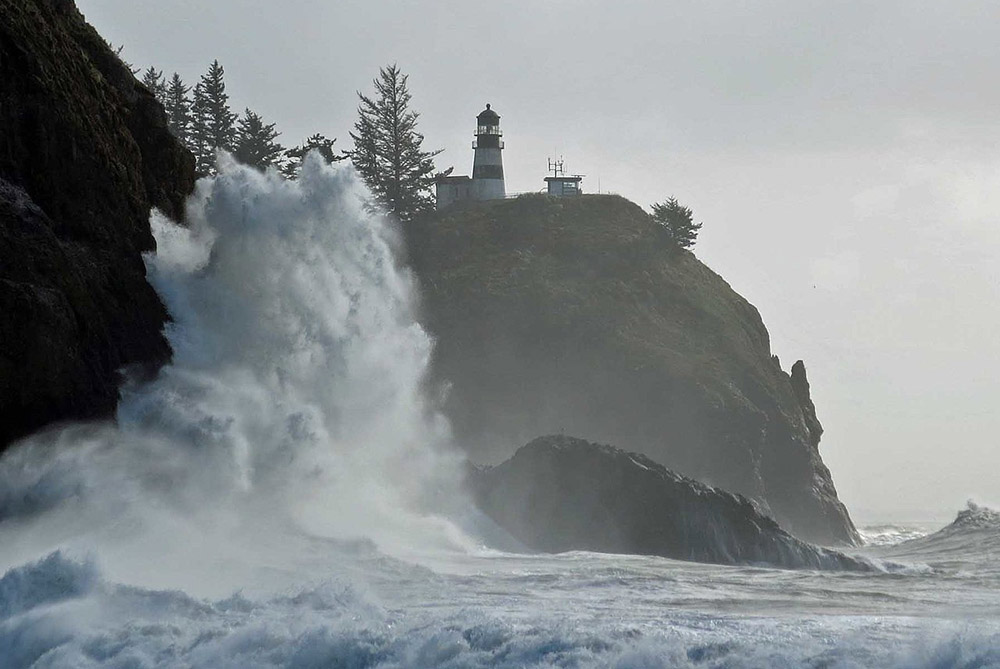
A wave breaks in front of the Cape Disappointment Lighthouse. (Photo Credit: James A. Tweedie under CC BY-SA 4.0)
Cape Disappointment has 137 campsites, 50 full-hookup sites, 18 partial-hookup sites with water and electricity, five primitive hiker/biker campsites, 14 yurts, three cabins, one dump station, eight restrooms and 14 showers. Whether you plan to rough it in your tent (bring rain gear and lots of layers!) or if you’d prefer to have a roof over your head, this campground has options for everyone. The yurts, in particular, are popular because of their proximity to the beach and their fire pits. All of the yurts are heated and sleep up to five people. The cabins also sleep five and have electric heat, lights and fire pits.
“There are beach views and art installations here, too,” Lipman says. “Also, the town of Astoria is nearby.”
Moran State Park Campgrounds
Best for Winter & Fall Camping in Solitude
Location: On Orcas Island, in the San Juan Islands
Fall/Winter Season: October through March
Dogs: Allowed
Access: Drive-up or walk-in, depending upon where you choose to camp
Accessible Sites Available: Yes; most of the campsites, all of the restrooms and the showers are accessible for campers with disabilities. We recommend calling a ranger before booking a winter camping trip, as some of the Mountain Lake sites may not be easily accessible.

A creek babbles its way through the contours of Moran State Park. (Photo Credit: Fletcherjcm under CC BY-SA 2.0)
Orcas Island, one of the larger islands in the San Juan archipelago, is known for its freshwater lakes, enjoyable hiking, cycling on more than 30 miles of trails and 360-degree views from Mount Constitution, which rises 2,409 feet above sea level. During the summer months, visitors come to swim, kayak, stand up paddle board and fish. During the fall and winter, the park offers something else entirely: quiet.
Moran State Park has 124 standard campsites, five biker/hiker sites, one dump station, five restrooms and 10 showers. During the summer, these sites are tough to come by—but during the fall and winter months, you should be able to snag a lake- or ocean-front site without much worry (but making a reservation is never a bad idea). The campsites are spread out, with some sites located by the swim beach, others near the Cascade Lake boat launch and still more sites built along the shoreline, plus six primitive sites located about a mile up Mount Constitution Road, on the shores of Mountain Lake. There’s also a group camp available. Most of these sites only stay open through the end of October, but the Mountain Lake Campground and Midway Campgrounds are open year-round.
“The nice thing about Moran is that you can camp in a lowland environment where you aren’t camping in snow, but you’re close enough to Mount Constitution’s snow—a lot of the hikes require snowshoes during the winter,” Lipman says.
Lake Wenatchee State Park
Best for Beginner Snow Campers
Location: Coles Corner, 16 miles from Leavenworth
Fall/Winter Season: October through March
Dogs: Allowed
Access: Drive-up
Accessible Sites Available: Yes; campsites and restrooms are accessible for campers with disabilities.
You’ll find Lake Wenatchee State Park just 16 miles past Leavenworth, Washington. The popular summer camping destination is nestled on Lake Wenatchee, a clear blue lake tucked into the mountains.
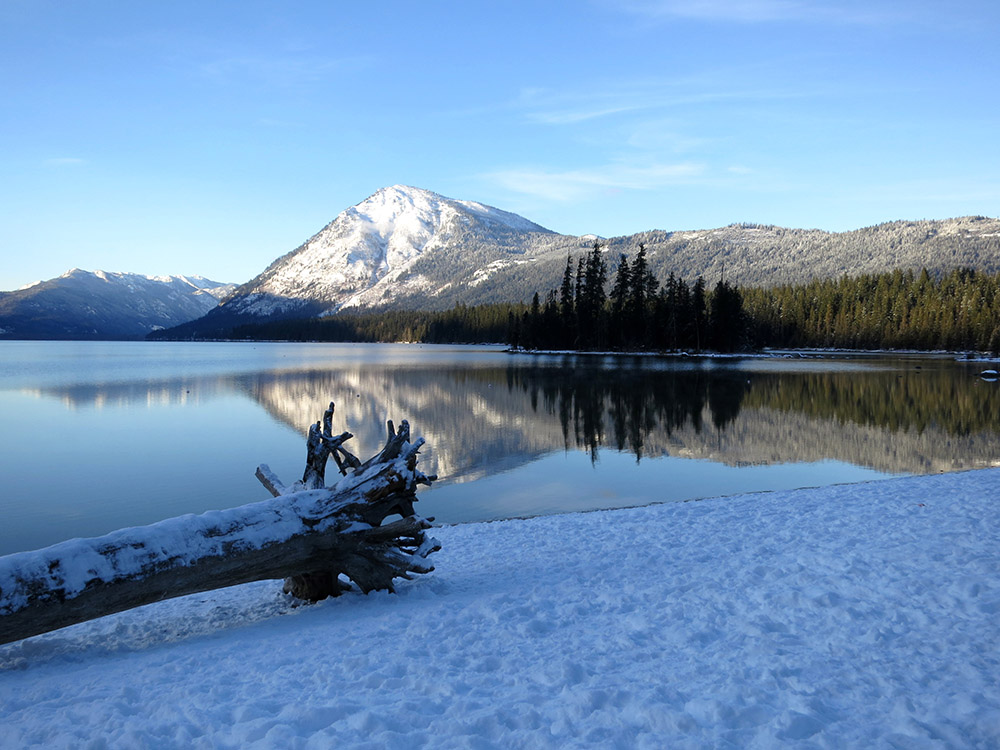
Dirtyface Peak towers above the Lake Wenatchee winterscape. (Photo Credit: Steve Cyr under CC BY-ND 2.0)
Although the park’s standard campsites close after the season’s first snow—usually around mid-November—the park also offers primitive camping year-round. You’ll have to pitch your tent using your snow-camping skills (deadman stakes, platform and all), but the area is relatively flat and you can drive up to the sites, making the experience as easy as possible. You’ll also have access to a warming hut, bathrooms, hot showers and a kitchen shelter for cooking. The site even has a tubing hill and snow play area for families.
“This is a fun place for practicing snow camping if you’ve never done it before,” says Lipman.
Fields Spring State Park
Best for Beginner Backcountry Snow Hikers
Location: Southeast Washington, near the Washington, Idaho and Oregon borders
Fall/Winter Season: October through March
Dogs: Allowed
Access: Walk-in or drive-up, depending on which cabins you choose
Accessible Sites Available: Restrooms are accessible to campers with disabilities; some cabins may be accessible but most are not. Call to check before booking.
Overlooking the Blue Mountains, Fields Spring State Park is a lesser-known park that covers miles of Washington, Oregon and Idaho backcountry. At Fields Spring, you’ll be able to enjoy the snow while sleeping in the comfort of a warm cabin or lodge. In fact, the park offers a few lodges, but our favorite options are two remote cabins: Tamarack Cabin near Wohelo Lodge sleeps four and offers a shower, mini-fridge and heat. You can park at the cabin and then enjoy the snow around it—especially the 6 miles of groomed, snowy trails that are perfect for cross-country skiing or snowshoeing.

Field Spring State Park’s Puffer Butte. (Photo Credit: Dsdugan under Public Domain)
The Puffer Butte Warming Hut, at the summit of Puffer Butte, is also a fun option. There’s a wood stove inside stocked with firewood, but you’ll have to bring everything else with you on your 1 mile snowshoe up to the hut. Four people can stay at the hut every night and you have to reserve your spot in advance (call 509-256-3332). A word to the wise: The hut is open to the public during the day but if you reserve your spot in advance, you’ll likely be the only one there at night.
“The Puffer Butte Warming Hut requires a short snowshoe hike,” says Lipman. “That will give you a fun, relatively safe introduction to winter backpacking.”
Skyline Lake Backcountry Camp
Best for Beginner Backcountry Snow Campers
Location: Stevens Pass, 36 miles from Leavenworth
Fall/Winter Season: October through March
Dogs: Allowed
Access: Walk-in
Accessible Sites Available: No
For an early season dose of snow, look no further than Stevens Pass, which is often the first area near Seattle to get quality powder.
Skyline Lake is one of our favorite easy snowshoeing routes—it’s just a little over 2.5 miles with 1,000 feet of elevation gain, topping out at an alpine lake. Start your trip from Lot D at the Stevens Pass Mountain Resort, where you’ll see groups of snowshoers and backcountry skiers heading up the backside of the hill, past several staff cabins and up the side of the mountain. (You can follow the WTA’s step-by-step directions). Once you reach Skyline Lake, set up camp and wait for all the hikers to leave. As the sun goes down, listen for crackling icicles. In the morning, catch an epic sunrise before heading back down to the ski lodge, where a hot breakfast and coffee await. If you’ve never camped in the backcountry, especially in the snow, consider joining a guided group.
Reflection & Louise Lakes Backcountry Camping
Best for Experienced Backcountry Snow Campers
Location: Near Paradise in Mount Rainier National Park, about 75 miles southeast of Tacoma
Fall/Winter Season: October through March
Dogs: Not Allowed
Access: Walk-in
Accessible Sites Available: No
While visitors flock to Mount Rainier National Park during the summer months, the crowds slow down in the fall and winter—which makes it the perfect time for a visit. You’ll need chains for your car (even if you don’t plan to use them) after mid-November, but most cars will be able to make it up the well-groomed roads of the park year-round, even without chains. We recommend entering the park from the west (Nisqually) entrance, 13.5 miles east of Elbe on State Route 706. Drive up to Paradise, exploring the park by car on your way. Park at the Narada Falls parking lot, then grab your snowshoes and trek up to Reflection Lake (consider following the WTA’s step by step instructions). If you choose, you can continue along to Louise Lake (about 3.5 miles from your car), just past Reflection Lake.
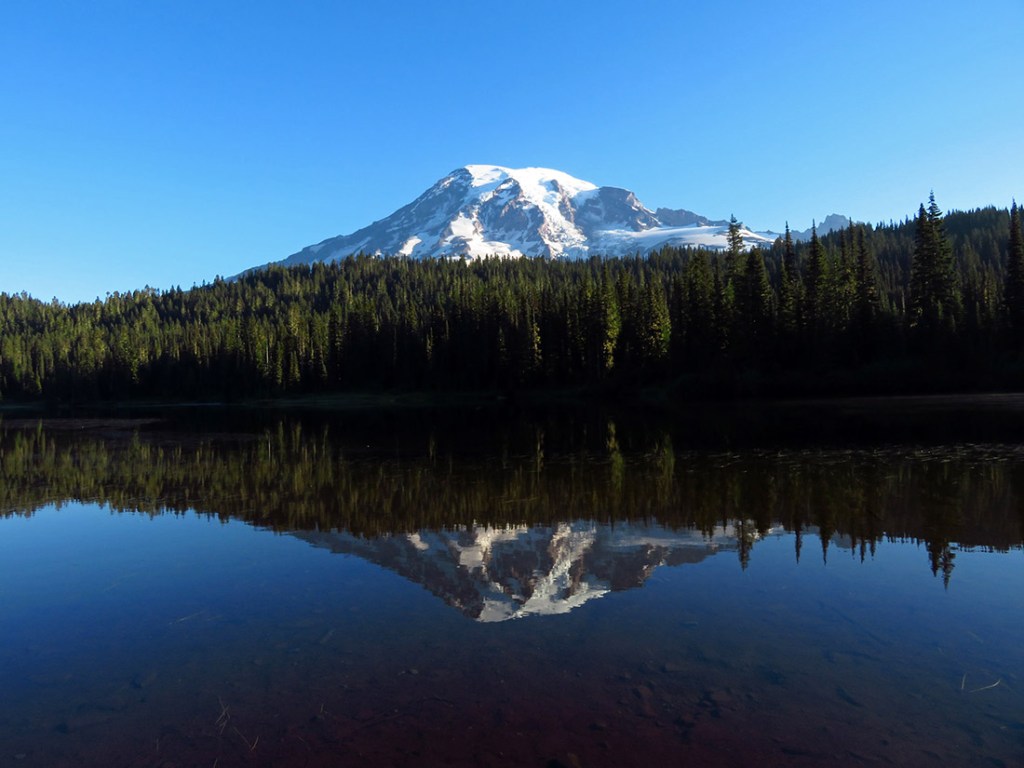
Mount Rainier reflects in the aptly named Reflection Lake. (Photo Credit: Jeff Hollett under Public Domain)
There are no amenities up here—it’s just you, the snow and epic sunrises over Mount Rainier. But we like this backcountry camping option because there’s a warming hut and a set of restrooms down by Narada Falls, where you (most likely) parked your car. The views are incredible, the payoff for your short hike is high, and the Paradise Visitor Center is nearby with restrooms, food, water, information and more. Be sure to check in with a ranger before you head out for a backcountry camp. If you’ve never winter camped in the backcountry before, consider joining a guided group. (Note: The National Park Service closes the Longmire-Paradise road at 5:30pm, so if you’re not planning to camp, the Park Service recommends leaving Paradise by 5pm to make the exit before closure.)
Artist Point Backcountry Camping
Also Best For Experienced Backcountry Snow Campers
Location: Mount Baker, about 55 miles east of Bellingham
Fall/Winter Season: October through March
Dogs: Not Allowed
Access: Walk-in
Accessible Sites Available: No
Park at the upper parking lot at Mt. Baker Ski Area, and then make your way up to Artist Point, a well known snowshoeing route that offers unparalleled views of the surrounding mountains on clear days. The best backcountry camping on Baker is located past Artist Point at Huntoon Point, which is about 3 miles one way from where you parked. (Use the WTA page for Huntoon Point for step-by-step directions).

A mid-winter Mt. Baker sunset as seen from Artist Point. (Photo Credit: U.S. Forest Service – Pacific Northwest Region under Public Domain)
If you’re lucky, you’ll be able to set up camp at Huntoon Point and catch an epic sunset and sunrise between Mount Baker and Mount Shuksan. Again, there are no amenities up here—it’s just you, the snow and the sky. Artist’s Point can get a bit busy, but once the sun starts to go down, you’ll likely be all alone with the views. Round trip, you’re looking at about 3 miles up and 3 miles down, with 1,200 feet of elevation gain. The lodge at the ski resort has food, hot drinks and restrooms. Again, if you’ve never backcountry camped, especially during the winter months, consider joining a guided group.
